| |
|
Xiamen Oil Paintings, Wholesale Direct!
|
|
100% hand painted, 100% cotton canvas, 100% money back if not satisfaction. |
|
|
|
|
ART WORKS INDEX
A
B
C
D
E
F
G
H
I
J
K
L
M
N
O
P
Q
R
S
T
U
V
W
X
Y
Z
|
|
ARTISTS INDEX
A
B
C
D
E
F
G
H
I
J
K
L
M
N
O
P
Q
R
S
T
U
V
W
X
Y
Z
|
|
|
|
 |
Geertgen Tot Sint Jans
|
|
Netherlandish Northern Renaissance Painter, ca.1460-1490
Geertgen tot Sint Jans is also known as Geertgen van Haarlem, Gerrit van Haarlem, or Gerrit Gerritsz.[citation needed] Alternative spellings of his first name are Gheertgen, Geerrit, and Gheerrit, where G(h)eertgen is the diminutive form of G(h)eerrit.
Presumably, he was born in Leiden, then in the Burgundian Netherlands in the Holy Roman Empire, around the year 1465. The assignment of Leiden as his birth place is traceable to a 17th century print by Jacob van Matham. There is no known archival evidence for this claim by Jacob van Matham. The modern acceptance of Leiden as Geertgen's birth place is roughly traceable to Johann Kessler's dissertation of 1930.
Probably, Geertgen was a pupil of Albert van Ouwater, who was one of the first oil painters in the northern Low Countries. Both painters lived in the city of Haarlem. Geertgen was attached to the monastery of the Knights of Saint John, for whom he painted an altarpiece. Although Geertgen was not a member of the Order of Saint John, his last name "tot Sint Jans" was derived from the order's name and means "unto Saint John".
Geertgen died in Haarlem, then the Habsburg Netherlands in the Holy Roman Empire, around the year 1495, when he was approximately 28 years old. He was buried in the monastery of the Knights of Saint John. Modern scholars have attempted to calculate the artist's death date with the information from The Painting-Book (Middle Dutch: Het Schilder-Boeck) by Karel van Mander, published in 1604. There are some archival traces that suggest he may in fact have lived into the 16th century.
|
|
|
|
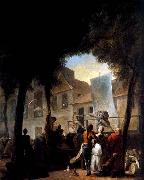 |
Gabriel Jacques de Saint-Aubin
|
|
French Painter, 1724-1780,Draughtsman, etcher and painter, brother of (1) Charles-Germain de Saint-Aubin. He studied with the painters Etienne Jeaurat and Hyacinthe Colin de Vermont, but failed three times to win the Prix de Rome (competition paintings, 1752-4; Paris, Louvre). He broke with the Academie Royale, preferring to support and exhibit at the Academie de St Luc. Although he continued to paint such pictures as a Street Show in Paris (c. 1760; London, N.G.; other examples in Rouen, Mus. B.-A.), he is best known as a draughtsman and etcher. He was a passionate and unconventional observer of the sights of the Paris streets and of the social scene. Dacier saw him as the 'man who drew at all times and in all places', and his contemporary Jean-Baptiste Greuze spoke of his 'priapism of draughtsmanship'. In his many drawings he combined pencil, black and red chalk, bistre, ink and watercolour to create dazzling spontaneous effects. He drew incidents that struck him as he wandered the streets, or entertainments that he attended. He recorded them, noting dates and times, in sketchbooks (e.g. Paris, Louvre and Stockholm, Nmus.) or sometimes in the margins and blank pages of printed books that he was carrying (such as a volume of the poems of Jean-Michel Sedaine, in the Mus. Cond?, Chantilly). These drawings of contemporary incidents include the Fire at the Foire Saint-Germain on the Night of 16-17 May 1762 (ex-David Weill priv. col.) and the Crowning of Voltaire at the Theetre-Franeais in 1778 (Paris, Louvre; see fig.). He went regularly to the Salon of the Academie Royale and to art sales, covering the margins and flyleaves of his sale catalogues and Salon livrets with tiny sketches of works of art and the passing scene. One hundred of these illustrated catalogues were among his effects when he died, and of these about a third survive. These include the livrets for the Salons of 1761, 1769 and 1777 (all Paris, Bib. N.), as well as the catalogues of the sales of Louis-Michel van Loo in 1772 and Charles Natoire in 1778 (both Paris, Bib. N.), and that of Pierre-Jean Mariette in 1775 (Boston, MA, Mus. F.A.). Together with his etchings and large watercolours (e.g. Paris, Louvre) of the Louvre's Salon Carre at the time of the exhibitions of 1753, 1767 and 1769,
|
|
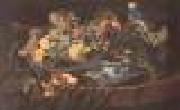 |
FYT, Jan
|
|
Flemish Baroque Era Painter, 1611-1661
Flemish painter, draughtsman and etcher. He was apprenticed in Antwerp in 1621-2 to Hans van den Berch [Berghe] (not to be confused with Jan van den Bergh of Alkmaar) and probably completed his training with Frans Snyders. In 1629-30 Fyt became a master in the Antwerp Guild of St Luke, but he continued to work for Snyders until 1631. In 1633 and 1634 he was in Paris. According to his biographers, he then went to Italy; an Italian journey is confirmed by the fact that in 1650 he joined the Antwerp Guild of Romanists (exclusive to those who had visited Rome), of which he became the dean in 1652. He apparently worked in Rome, where he joined the Schildersbent and was given the nickname 'Goudvink' (Dut.: 'goldfinch'). In Venice, according to Orlandi, Fyt worked for the Sagredo and Contarini families. He is also thought to have visited Naples, Florence and Genoa, and Orlandi stated that he also went to Spain and London. By 5 September 1641 Fyt was back in Antwerp, where, apart from a brief trip to the northern Netherlands in 1642, he apparently remained for the rest of his career.
|
|
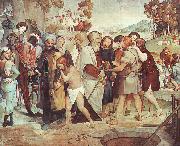 |
Friedrich Johann Overbeck
|
|
1789-1869
German
German religious painter. Expelled from the Vienna Academy because of his opposition to its classicism, he went to Rome and with Peter von Cornelius, Veit, Schadow-Godenhaus, and others, formed the group known as the Nazarenes. His first real successes were his frescoes for the Casa Bartholdy (now in Berlin) and for the Villa Massimo. Among his notable paintings are Christ Entry into Jerusalem and Christ Agony in the Garden. Overbeck sought to make his art serve religion. His influence was due more to the purity of his doctrine than to the power of his work, which is often lacking in pictorial appeal and in color.
|
|
|
|
|
|
|
|
|
|
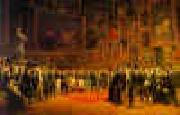 |
Francois-Joseph Heim
|
|
1787-1865
French Francois-Joseph Heim Gallery
He was born at Belfort. He early distinguished himself at the Ecole Centrale of Strassburg, and in 1803 entered the studio of Vincent at Paris. In 1807 he obtained the first prize, and in 1812 his picture of The Return of Jacob (Musee de Bordeaux) won for him a gold medal of the first class, which he again obtained in 1817, when he exhibited, together with other works, a St John-bought by Vivant Denon.
In 1819 the Resurrection of Lazarus (Cathedral Autun), the Martyrdom of St Cyr (St Gervais), and two scenes from the life of Vespasian (ordered by the king) attracted attention. In 1823 the Re-erection of the Royal Tombs at St Denis, the Martyrdom of St Laurence (Nôtre Dame) and several full-length portraits increased the painter popularity; and in 1824, when he exhibited his great canvas, the Massacre of the Jews (Louvre), Heim was rewarded with the Legion of Honour.
In 1827 appeared the King giving away Prizes at the Salon of 1824 (Louvre-engraved by Jazet) the picture by which Heim is best known and Saint Hyacinthe. Heim was now commissioned to decorate the Gallery Charles X (Louvre). Though ridiculed by the romantists, Heim succeeded Regnault at the Institute in 1834, shortly after which he commenced a series of drawings of the celebrities of his day, which are of much interest.
His decorations of the Conference room of the Chamber of Deputies were completed in 1844; and in 1847 his works at the Salon Champ de Mai and Reading a Play at the Theatre Francais were the signal for violent criticisms. Yet something like a turn of opinion in his favour took place at the exhibition of 1851; his powers as draughtsman and the occasional merits of his composition were recognized, and toleration extended even to his colour.
Heim was awarded the great gold medal, and in 1855-having sent to the Salon no less than sixteen portraits, amongst which may be cited those of Cuvier, Geoffroy de St Hilaire, and Madame Hersent he was made officer of the legion of honour. In 1859 he again exhibited a curious collection of portraits, sixty-four members of the Institute arranged in groups of four.
Besides the paintings already mentioned, there is to be seen in Notre Dame de Lorette (Paris) a work executed on the spot; and the museum of Strassburg contains an excellent example of his easel pictures, the subject of which is a Shepherd Drinking from a Spring.
|
|
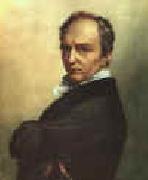 |
Francois Joseph Navez
|
|
1787-1869
French
Francois Joseph Navez gallery
Francois-Joseph Navez (Charleroi, 1787 - Brussels, 1869) was a Belgian neo-classical painter.
A pupil of Jacques-Louis David, he spent five years in Italy between 1817 and 1822.
He was a very successful portrait painter. He also painted many mythological and historic subjects.
The orientalist painter Jean-Francois Portaels was his pupil (and son-in-law).
|
|
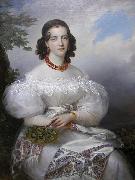 |
Francois Joseph Kinson
|
|
François-Joseph Kinson (1771-1839) was a Flemish painter.
Kinson attended art school at Bruges and soon established a reputation in Ghent and Brussels. He exhibited a portrait in Paris in 1799. Settling in Paris after the exhibition, the artist courted the favor of the rich and famous of the time. Kinson worked for Napoleones court and eventually became court painter to Jerôme Bonaparte, King of Westphalia. Kinson is best remembered for his portraits of elegant women. The artist worked as a court painter in Paris until 1830, and died in 1839 at the age of 68.
|
|
 |
Francois Joseph Heim
|
|
(16 December 1787 - 29 September 1865) was a French painter.
He was born at Belfort. He early distinguished himself at the École Centrale of Strassburg, and in 1803 entered the studio of Vincent at Paris. In 1807 he obtained the first prize, and in 1812 his picture of "The Return of Jacob" (Musee de Bordeaux) won for him a gold medal of the first class, which he again obtained in 1817, when he exhibited, together with other works, a St John--bought by Vivant Denon.
In 1819 the "Resurrection of Lazarus" (Cathedral Autun), the "Martyrdom of St Cyr" (St Gervais), and two scenes from the life of Vespasian (ordered by the king) attracted attention. In 1823 the "Re-erection of the Royal Tombs at St Denis," the "Martyrdom of St Laurence" (Nôtre Dame) and several full-length portraits increased the painter's popularity; and in 1824, when he exhibited his great canvas, the "Massacre of the Jews" (Louvre), Heim was rewarded with the Legion of Honour.
In 1827 appeared the "King giving away Prizes at the Salon of 1824" (Louvre--engraved by Jazet) the picture by which Heim is best known and "Saint Hyacinthe." Heim was now commissioned to decorate the Gallery Charles X (Louvre). Though ridiculed by the romantists, Heim succeeded Regnault at the Institute in 1834, shortly after which he commenced a series of drawings of the celebrities of his day, which are of much interest.
His decorations of the Conference room of the Chamber of Deputies were completed in 1844; and in 1847 his works at the Salon "Champ de Mai" and "Reading a Play at the Theâtre Français" were the signal for violent criticisms. Yet something like a turn of opinion in his favour took place at the exhibition of 1851; his powers as draughtsman and the occasional merits of his composition were recognized, and toleration extended even to his colour.
Heim was awarded the great gold medal, and in 1855--having sent to the Salon no less than sixteen portraits, amongst which may be cited those of Cuvier, Geoffroy de St Hilaire, and Madame Hersent he was made officer of the legion of honour. In 1859 he again exhibited a curious collection of portraits, sixty-four members of the Institute arranged in groups of four.
Besides the paintings already mentioned, there is to be seen in Nôtre Dame de Lorette (Paris) a work executed on the spot; and the museum of Strassburg contains an excellent example of his easel pictures, the subject of which is a Shepherd Drinking from a Spring.
cjr
|
|
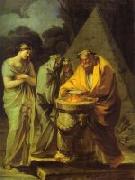 |
Francisco Jose de Goya
|
|
Spanish Rococo Era/Romantic Painter and Printmaker, 1746-1828
Goya is considered the 18th Century's foremost painter and etcher of Spanish culture, known for his realistic scenes of battles, bullfights and human corruption. Goya lived during a time of upheaval in Spain that included war with France, the Inquisition, the rule of Napoleon's brother, Joseph, as the King of Spain and, finally, the reign of the Spanish King Ferdinand VII. Experts proclaim these events -- and Goya's deafness as a result of an illness in 1793 -- as central to understanding Goya's work, which frequently depicts human misery in a satiric and sometimes nightmarish fashion. From the 1770s he was a royal court painter for Charles III and Charles IV, and when Bonaparte took the throne in 1809, Goya swore fealty to the new king. When the crown was restored to Spain's Ferdinand VII (1814), Goya, in spite of his earlier allegiance to the French king, was reinstated as royal painter. After 1824 he lived in self-imposed exile in Bordeaux until his death, reportedly because of political differences with Ferdinand. Over his long career he created hundreds of paintings, etchings, and lithographs, among them Maya Clothed and Maya Nude (1798-1800); Caprichos (1799-82); The Second of May 1808 and The Third of May 1808 (1814); Disasters of War (1810-20); and The Black Paintings (1820-23).
|
|
|
|
|
|
|
|
|
|
 |
Fitz Hugh Lane
|
|
1804-1865
Fitz Henry Lane was born on December 19, 1804, in Gloucester, Massachusetts. Lane was christened Nathaniel Rogers Lane on March 17, 1805, and would remain known as such until he was 27. It was not until March 13, 1832 that the state of Massachusetts would officially grant Lane??s own formal request (made in a letter dated December 26, 1831) to change his name from Nathaniel Rogers to Fitz Henry Lane. As with practically all aspects of Lane??s life, the subject of his name is one surrounded by much confusion??it was not until 2005 that historians discovered that they had been wrongly referring to the artist as Fitz Hugh, as opposed to his chosen Fitz Henry, and the reasons behind Lane??s decision to change his name, and for choosing the name he did, are still very unclear.
From the time of his birth, Lane would be exposed to the sea and maritime life??a factor that obviously had a great impact his later choice of subject matter. Many circumstances of his young life ensured Lane??s constant interaction with various aspects of this maritime life, including the fact that Lane??s family lived ??upon the periphery of Gloucester Harbor??s working waterfront,?? , and that his father, Jonathan Dennison Lane, was a sailmaker, and quite possibly owned and ran a sail loft. It is often speculated that Lane would most likely have pursued some sea-faring career, or become a sail-maker like his father, instead of an artist, had it not been for a life-long handicap Lane developed as a child. Although the cause cannot be known with complete certainty, it is widely accepted most plausible that the ingestion of some part of the Peru-Apple??a poisonous weed also known as jimsonweed??by Lane at the age of eighteen months caused the paralysis of the legs from which Lane would never recover. It is suggested, and seems logical to assume, that because he could not play games as the other children did, he was forced to find some other means of amusement, and that in such a pursuit he discovered and was able to develop his talent for drawing. To go a step further, as a result of his having a busy sea-port as immediate surroundings, he was able to develop a special skill in depicting the goings-on inherent in such an environment.
It is true that Lane could still have become a sail-maker, as such an occupation entailed much time spent sitting and sewing, and that Lane already had some experience sewing from his short-lived apprenticeship in shoe-making. However, as evidenced in this quote from Lane??s nephew Edward Lane??s ??Early Recollections,?? his interest in art held much sway in his deciding on a career: ??Before he became an artist he worked for a short time making shoes, but after a while, seeing that he could draw pictures better than he could make shoes he went to Boston and took lessons in drawing and painting and became a marine artist.??
Lane acquired such ??lessons?? by way of his employment at Pendleton??s lithography shop in Boston, which lasted from 1832 to 1847. With the refinement and development of his artistic skills acquired during his years working as a lithographer, Lane was able to successfully produce marine paintings of high quality, as evidenced in his being listed, officially, as a ??marine painter?? in the Boston Almanac of 1840. Lane continued to refine his painting style, and consequently, the demand for his marine paintings increased as well.
Lane had visited Gloucester often while living in Boston, and in 1848, he returned permanently. In 1849, Lane began overseeing construction of a house/studio of his own design on Duncan??s Point??this house would remain his primary residence to the end of his life. Fitz Henry Lane continued to produce beautiful marine paintings and seascapes into his later years. He died in his home on Duncan??s Point on August 14, 1865, and is buried in Oak Grove Cemetery.
|
|
 |
Fisher Jonathan
|
|
American.
b.1768 d.1847
was the first Congregational minister from 1794 to 1837 in the small village of Blue Hill, Maine in the United States. Although his primary duties as a country parson engaged much of his time, Fisher was also a farmer, scientist, mathematician, surveyor, and writer of prose and poetry. He bound his own books, made buttons and hats, designed and built furniture, painted sleighs, was a reporter for the local newspaper, helped found Bangor Theological Seminary, dug wells, built his own home and raised a large family. Truly a renaissance man in the breadth of his accomplishments Fisher invites comparison with a Franklin or Jefferson. In his manners, morals and writings Fisher represents the best of the vigorous New England churchmen who shaped the standards of their congregations during America's formative years.
|
|
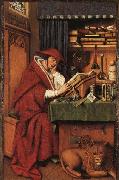 |
EYCK, Jan van
|
|
Flemish Northern Renaissance Painter, ca.1395-1441
Painter and illuminator, brother of Hubert van Eyck. According to a 16th-century Ghent tradition, represented by van Vaernewijck and Lucas d'Heere, Jan trained with his brother Hubert. Pietro Summonte's assertion (1524) that he began work as an illuminator is supported by the fine technique and small scale of most of Jan's works, by manuscript precedents for certain of his motifs, and by his payment in 1439 for initials in a book (untraced) for Philip the Good, Duke of Burgundy. Jan is first documented in The Hague in August 1422 as an established artist with an assistant and the title of 'Master', working for John III, Count of Holland (John of Bavaria; reg 1419-25), who evidently discovered the artist while he was bishop (1389-1417) of the principality of Liege.
|
|
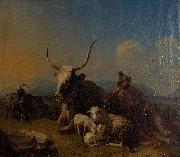 |
Eugne Joseph Verboeckhoven
|
|
(1790-1881), Belgian painter, was born at Warneton in West Flanders, and received instruction in drawing and modelling from his father, the sculptor Barthelemy Verboeckhoven. Subsequently he settled in Brussels and devoted himself almost exclusively to animal subjects.
Shepherd with animals in the countryside
attributed to Eugene Verboeckhoven - private collectionHis paintings of sheep, of horses and of cattle in landscape, somewhat after the manner of Paulus Potter, brought him universal fame, and were eagerly sought for by collectors. Precise and careful finish is the chief quality of his art, which is entirely objective and lacking in inspiration. Verboeckhoven visited England in 1826, Germany in 1828, and France and Italy in 1841, and died at Brussels in 1881. He was a member of the academies of Brussels, Ghent, Antwerp, St. Petersburg and Amsterdam. Examples of his art are to be found in nearly all the important galleries of Europe and the United States, notably in Brussels, Antwerp, Amsterdam, Hamburg, Berlin, Munich, New York, Boston and Washington D.C.. His long life and ceaseless industry account for the enormous number of his pictures in public and private collections and in the art market. In addition to his painted work he executed some fifty etched plates of similar subjects.
|
|
|
|
|
|
|
|
 |
ES, Jacob van
|
|
Flemish painter (b. ca. 1596, Antwerpen, d. 1666, Antwerpen)
Flemish painter. Together with Osias Beert and Clara Peeters, he was one of the leading representatives of the archaizing trend in Flemish still-lifes. His birthplace is known from the text on an engraving by Wenceslaus Hollar after a painting by Jan Meyssens (1612-70). Van Es became a master in Antwerp in 1617 but did not join the Guild of St Luke until 1645. Jacob Gillis and Jan van Thiene were his pupils in 1621 and 1623 respectively. He enjoyed a certain esteem among fellow artists, for Jacob Jordaens, Cornelis Schut the elder and Deodaat del Monte were godfathers to his children. Numerous mentions of works by van Es in inventories of 17th-century Antwerp collectors further testify to his success
|
|
 |
Ernst Josephson
|
|
1851-1906
Swedish
Ernst Josephson Gallery
was a Swedish painter from a prominent Jewish family, whose main work was done on portraits and paintings of folk life.
He did his art studies in Italy, France and the Netherlands, among others, and is reputed to have said at the age of 20: "I will become Sweden's Rembrandt or die."
However, his life was marred by illness. He contracted syphilis at a relatively young age, and in 1888 he became mentally ill during a visit to Brittany, having religious hallucinations and believing that he was God and Christ.
He was later taken to hospital in Uppsala and diagnosed with schizophrenia, but continued working throughout his disease, often while in a trance-like state.
He also wrote poetry, in the collections Svarta rosor (1888, Black Roses) and Gula rosor (1896, Yellow Roses). His main work, Strömkarlen (1884, the Nix), was refused by the Swedish National Museum in Stockholm - however, Prince Eugen, Duke of Narke, bought the painting in fury over the decision.
Grandfather of Erland Josephson.
|
|
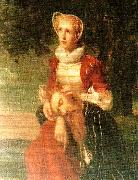 |
Erik Johan lofgren
|
|
Erik Johan Löfgren (15. lokakuuta 1825 Turku -- 10. joulukuuta 1884) oli suomalainen taidemaalari.
Löfgrenin vanhemmat olivat kauppias Johan Gabriel Löfgren ja Katarina Erikintytär o.s. Vahlsten. Hän opiskeli T. J. Leglerin johdolla Ruotsin kuninkaallisessa taideakatemiassa Tukholmassa 1842?C1850 ja sitten D??sseldorfin taideakatemiassa O. Mengelbergin ja F. Th. Hildebrandtin johdolla 1853?C1858.
Löfgren toimi taulujen restauroijana Tukholmassa 1842?C1853 ja myöhemmin 1870-luvulla hän oli opettajana Helsingin yliopiston piirustussalissa. Hänen maalaustyylinsä oli lyyrisen romanttista ja hän maalasi muotokuvia sekä historian tapahtumista aiheensa saaneita maalauksia.
|
|
 |
Enoch Wood Perry, Jr.
|
|
(1831-1915) was a painter from the United States.
Perry was born in Boston on July 31, 1831. His father was Enoch Wood Perry, and mother was Hannah Knapp Dole. His maternal grandparents were Samuel Dole and Katherine Wigglesworth. The family moved to New Orleans with his family as a teenager in 1848 and attended its public schools. After working several years as a clerk in a commission house, Perry began formal art education. In 1852 he went to Europe for four years and studied with Emanuel Leutze at the Desseldorf Academy, Thomas Couture in Paris, and in Rome.Perry served as the U.S. Consul to Venice between 1856 and 1858. Upon returning to America, he opened a studio in Philadelphia.
|
|
|
|
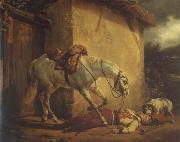 |
Emile Jean Horace Vernet
|
|
French, 1789-1863,Painter, son of Carle Vernet. He was born in his father's lodgings at the Palais du Louvre, where his grandfather Joseph Vernet also lived; his maternal grandfather was Jean-Michel Moreau. To these antecedents and influences are ascribed the supreme ease of his public career, his almost incredible facility and his fecundity. His early training in his father's studio was supplemented by formal academic training with Francois-Andre Vincent until 1810, when he competed unsuccessfully for the Prix de Rome. He first exhibited at the Salon in 1812. In 1814 Vernet received the Legion d'honneur for the part he played in the defence of Paris, which he commemorated in the Clichy Gate: The Defence of Paris, 30 March 1814.
|
|
|
|
 |
Elizabeth Jane Gardner
|
|
(October 4, 1837-January 28, 1922) was an American academic and salon painter, who was born in Exeter, New Hampshire. She was an American expatriate who died in Paris where she had lived most of her life. She studied in Paris under the figurative painter Hugues Merle (1823-1881), the well-known salon painter Jules Joseph Lefebvre (1836-1911), and finally under William-Adolphe Bouguereau (1825-1905). After Bouguereau's wife died, Gardner became his paramour and after the death of his mother, who bitterly opposed the union, she married him in 1896. She adopted his subjects, compositions and even his smooth facture, adopted them so successfully that some of her work might be mistaken for his. Gardner's best known work may be The Shepherd David Triumphant (1895), which shows the young shepherd with the lamb he has rescued. Among her other works were "Cinderella," "Cornelia and Her Jewels," "Corinne," "Fortune Teller," "Maud Muller," "Daphne and Chloe," "Ruth and Naomi," "The Farmer's Daughter," "The Breton Wedding," and some portraits.
|
|
 |
Elisabeth Jerichau Baumann
|
|
(born November 21, 1819 - died July 11, 1881 in Copenhagen) was a Polish-born Danish painter. She was married to the sculptor Jens Adolf Jerichau.
Elisabeth Jerichau-Baumann was born in Zoliborz (Jolibord) a borough of Warsaw.Her father Philip Adolph Baumann (1776 - 1863), a mapmaker, and her mother, Johanne Frederikke Reyer (1790 - 1854), were German.
At the age of nineteen, she began her studies in Desseldorf which at the time was one of the most important art centres in Europe and her early subject matter was drawn from Slovak life. She began exhibiting there and in 1844 attracted public attention for the first time. After she moved to Rome, her paintings were primarily of local life. It was here that she met her future husband, Jens Adolf Jerichau, whom she married in 1846. When the artist couple was not travelling, she spent many hours a day in their studio in Rome. She was particularly fond of the Italian carnival as a theme.
|
|
|
|
|
|
|
|
 |
Eero Jarnefelt
|
|
(8 November 1863 - 15 November 1937) was a Finnish realist painter.
Eero Järnefelt was born in Viipuri, Finland. His father August Aleksander Järnefelt was an officer in the Russian army and his mother was Elisabeth Järnefelt. He studied at the St. Petersburg art academy between 1883 and 1885, the same school at which Albert Edelfelt had studied. Eero Järnefelt's sister Aino Järnefelt married composer Jean Sibelius in 1892,
Eero Järnefelt's sisters and brothers were Kasper, Arvid, Aino Ellida, Ellen, Armas, Hilja and Sigrid.
He went to study in Paris in 1886, where he became friends with Akseli Gallen-Kallela, Emil Wikström and Louis Sparre. He was inspired by the plein-air and naturalistic paintings of Jules Bastien-Lepage
On a trip to Keuruu in 1889, he met actress Saimi Swan. They were married in 1890.
His most famous painting is probably The Wage Slaves (Raatajat rahanalaiset or Kaski, from 1893, External link), depicting slash-and-burn agriculture.
|
|
 |
Edward Jukes Greig
|
|
b. 1839 Melbourne, Victoria
Also known as E. J. G.
Artist (Draughtsman), (Cartoonist / Illustrator), (Painter)
Colonial Victorian painter, cartoonist and illustrator.
Birth datec.1839Birth placeMelbourne, VictoriaDeath date4 October 1864Death placeSydney, New South Wales.
Residence 1864 11 Crown Street, Millers Point, Sydney, New South Wales
c.1860- c.1864 171 Victoria Parade, Melbourne, Victoria
Active Period 1860- 1864
|
|
|
|
 |
Edward John Eyre
|
|
1815-1901,British colonial administrator. In Australia (1833?C45) he was a magistrate, explorer, and writer on Australian geography, and had a reputation for sympathy for the aborigines. After terms as lieutenant governor of New Zealand (1846?C53) and governor of St. Vincent (1854?C60), he became (1864) governor of Jamaica. He was recalled in 1866 after suppressing a black uprising the year before in which more than four hundred Jamaicans were executed. Eyre was accused of brutality and illegal acts, especially in the execution of George Gordon, a black member of the Jamaican legislature who had contravened the martial law imposed during the emergency. He was recalled in 1866. Several attempts, promoted by John Stuart Mill, Goldwin Smith, and Herbert Spencer, to try him for murder were forestalled by a committee of admirers, which included John Ruskin, Alfred Tennyson, Thomas Carlyle, and Charles Kingsley. An English grand jury declined to indict him, and a royal commission exonerated him, while criticizing his ??unnecessary rigour.?? The episode contributed to the fall of the government of Lord John Russell in 1866.
|
|
 |
Edward Burne-Jones
|
|
British Pre-Raphaelite Painter, 1833-1898
English painter and decorative artist. He was the leading figure in the second phase of the Pre-Raphaelite movement. His paintings of subjects from medieval legend and Classical mythology and his designs for stained glass, tapestry and many other media played an important part in the Aesthetic Movement and the history of international Symbolism.
|
|
 |
Edward Burne Jones
|
|
Sir Edward Coley Burne-Jones, 1st Baronet (28 August 1833 - 17 June 1898) was a British artist and designer closely associated with the later phase of the Pre-Raphaelite movement, who worked closely with William Morris on a wide range of decorative arts as a founding partner in Morris, Marshall, Faulkner, and Company. Burne-Jones was closely involved in the rejuvenation of the tradition of stained glass art in England; his stained glass works include the windows of St. Philip's Cathedral, Birmingham, Holy Trinity Church, Sloane Square, Chelsea, St Martin's Church in Brampton, St Michael's Church in Brighton, Cumbria, the church designed by Philip Webb, All Saints, Jesus Lane, Cambridge and in Christ Church, Oxford.
Burne-Jones's early paintings show the heavy inspiration of Dante Gabriel Rossetti, but by the 1860s Burne-Jones was discovering his own artistic "voice". In 1877, he was persuaded to show eight oil paintings at the Grosvenor Gallery (a new rival to the Royal Academy). These included The Beguiling of Merlin. The timing was right, and he was taken up as a herald and star of the new Aesthetic Movement.
In addition to painting and stained glass, Burne-Jones worked in a variety of crafts; including designing ceramic tiles, jewellery, tapestries, mosaics and book illustration, most famously designing woodcuts for the Kelmscott Press's Chaucer in 1896.
Edward Coley Burne Jones (the hyphen came later) was born in Birmingham, the son of a Welshman, Edward Richard Jones, a frame-maker at Bennetts Hill, where a blue plaque commemorates the painter's childhood. His mother Elizabeth Coley Jones died within six days of his birth, and he was raised by his grieving father and the family housekeeper, Ann Sampson, an obsessively affectionate but humorless and unintellectual local girl. He attended Birmingham's King Edward VI grammar school from 1844 and the Birmingham School of Art from 1848 to 1852, before studying theology at Exeter College, Oxford. At Oxford he became a friend of William Morris as a consequence of a mutual interest in poetry. The two Exeter undergraduates, together with a small group of Jones' friends from Birmingham known as the Birmingham Set, speedily formed a very close and intimate society, which they called "The Brotherhood". The members of the Brotherhood read John Ruskin and Tennyson, visited churches, and worshipped the Middle Ages. At this time Burne-Jones discovered Thomas Malory's Le Morte d'Arthur which was to be so influential in his life. At that time neither Burne-Jones nor Morris knew Rossetti personally, but both were much influenced by his works, and met him by recruiting him as a contributor to their Oxford and Cambridge Magazine which Morris founded in 1856 to promote their ideas.[
|
|
|
|
|
|
|
|
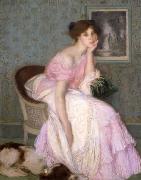 |
Edmond Aman-Jean
|
|
(1858 - 1936) was a French symbolist painter, who founded the Salon des Tuileries. It is also noted that he was a friend of Georges Seurat.
|
|
 |
Eastman Johnson
|
|
American portrait and genre painter, 1824-1906
American painter and printmaker. Between 1840 and 1842 he was apprenticed to the Boston lithographer John H. Bufford (1810-70). His mastery of this medium is apparent in his few lithographs, of which the best known is Marguerite (c. 1865-70; Worcester, MA, Amer. Antiqua. Soc.). In 1845 he moved to Washington, DC, where he drew portraits in chalk, crayon and charcoal of prominent Americans, including Daniel Webster, John Quincy Adams and Dolly Madison (all 1846; Cambridge, MA, Fogg). In 1846 he settled in Boston and brought his early portrait style to its fullest development. His chiaroscuro charcoal drawings, of exceptional sensitivity, were remarkably sophisticated for an essentially self-trained artist. In 1848 he travelled to Europe to study painting at the D?sseldorf Akademie. During his two-year stay he was closely associated with Emanuel Leutze, and painted his first genre subjects
|
|
 |
e. j. f. bendemann
|
|
Eduard Julius Friedrich Bendemann (3 December 1811, Berlin - 27 December 1889, Dusseldorf) was a German painter.
Bendemann was born in Berlin. His father, Anton Heinrich Bendemann, a Jewish banker, monitored his education closely; it was one that would have naturally led him to some sort of technical occupation, but his talent and propensity towards art resulted in his being allowed to pursue other interests. His mother Fanny Eleonore Bendemann nee von Halle, also a daughter of the Jewish banker Joel Samuel von Halle.
After he completed elementary school he enrolled in the Wilhelm von Schadow's School in Dusseldorf. In 1830 he went on a school trip to Italy. After a series of jobs, among them with Boas and Ruth, his talent as an artist began to show, especially with his very large 1832 painting titled, The Sad Jews of Babylon which was featured in the Berlin art exhibition. The picture garnered a great deal of attention, which was in part due to the deep and simple feeling and the noble composition of the piece (museum in Cologne). Bendemanns second picture: The Two Girls at the Well (1832), was acquired by the North Rhine-Westphalia art association.
Soon thereafter followed Jeremias on the Ruins of Jerusalem for which the artist received a medal in Paris in 1837. This painting was for the most part about the progress of the Jews in Babylon. (Royal Palace in Hanover). His best known work is The Harvest.
The artist's first fresco was a symbolic representation of the art at the Poetry Well at the house of his parents-in-law in Berlin. In the year 1838 he was appointed professor of the academy of arts in Dresden, where he had the opportunity to paint even larger frescos. Bendemann was given the task to decorate three halls of the Dresden royal palace, the throne room, the tower room, and the tower hall with wall paintings. In the throne room, on both sides of the throne, there are representations of important rulers and legislators in gold leaf with smaller representations in relief form below, from Moses up to Albrecht III, the King at the time. On the wall facing the throne there are four paintings depicting events from the life of King Heinrich I each with other pictures attached which explain each of the four events. Bendemann died in Dusseldorf.
|
|
|
|
|
|
|
|
|
|
|
| Wholesale China Oil Painting Wholesale Oil Painting China Xiamen Portrait Reproduction on canvas Chinese Oil Painting Wholesale USA Oil Painting |
|
|
|
|
|